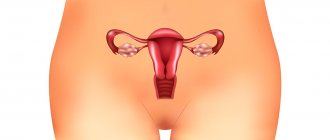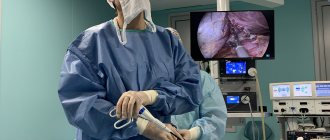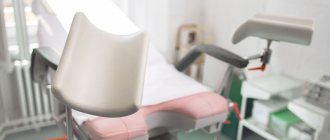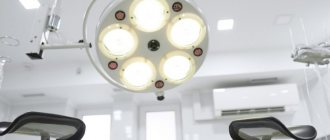Hysteroscopy of the uterus, although minimally invasive, is still an operation, so it has a number of contraindications. Before the procedure, the patient undergoes examinations that allow her to assess the condition of the body (ultrasound of the pelvic organs, general and biochemical blood tests, urine tests, gynecological smears, as well as a blood test for HIV, hepatitis and sexually transmitted infections). The attending physician may prescribe additional examinations depending on the picture of the disease. If the test results show any abnormalities, the hysteroscopy will be rescheduled or cancelled.
What is hysteroscopy
Hysteroscopy is used for various purposes: diagnostics, to monitor the condition of the organ after surgery, to monitor the effectiveness of treatment, to perform simple surgical operations.
Hysteroscopy is performed using a hysteroscope, a device that is an ultra-thin optical instrument. The hysteroscope is equipped with a camera that transmits images of the examined area of the cavity to the screen. The procedure is carried out with tenfold magnification, which allows you to clearly see areas of pathology.
- Diagnostic hysteroscopy
– with the help of diagnostic hysteroscopy, the following intrauterine diseases are identified: endometrial hyperplasia, uterine fibroids, synechiae of the uterine cavity, polyps, malignant neoplasms and other diseases. - Surgical hysteroscopy
is an invasive procedure that is performed to treat pathologies of the uterine cavity: polyps, fibroids, eliminates adhesions, remnants of the fertilized egg after an abortion or childbirth, and other pathologies. - Control hysteroscopy
– performed after treatment of diseases and pathologies of the uterine cavity. This procedure will help to detect the leg of the polyp remaining in the cavity after removal of the polyp, the remains of the fertilized egg after an abortion, and other pathologies.
Indications for hysteroscopy, diagnosis of diseases:
- adenomyosis, endometriosis;
- infertility;
- unsuccessful in vitro fertilization;
- abnormal development of the uterus;
- endometrial polyps;
- submucosal uterine fibroids;
- menstrual irregularities;
- cervical cancer, uterine cancer;
- assessment of the consistency of the scar after cesarean section, myomectomy, uterine perforation - preparation for pregnancy;
- removal of an intrauterine device that has grown into the uterine tissue;
- monitoring the condition of the uterine cavity after abortion, drug therapy;
- removal of adhesions in the uterine cavity.
Hysteroscopy is most often performed under general anesthesia, which allows immediate diagnosis and surgical treatment of the disease. Before hysteroscopy, a complete examination of the patient is prescribed according to the preparation plan for surgery. After hysteroscopy, you do not need to be in a hospital; the procedure is performed on an outpatient basis.
Hysteroscopy can eliminate the following symptoms:
- spotting, which often appears during menopause,
- difficulty conceiving,
- pain during sexual intercourse,
- miscarriage,
- premenstrual syndrome,
- dysmenorrhea,
- prolonged, spotting discharge,
- amenorrhea,
- premature menopause.
When the hysteroscopy procedure cannot be performed:
- progressive pregnancy
- late stages of cervical cancer,
- cervical stenosis,
- inflammatory process of the genitals,
- the patient is sick with ARVI, acute respiratory infections or other infectious diseases,
- severe form of the disease (heart attack, stroke, renal failure, cardiovascular failure), serious condition of the patient (decompensation of diabetes mellitus and others).
There are certain rules for performing hysteroscopy:
- Hysteroscopy is prescribed in relation to the days of the cycle and the nature of the pathology (the first phase of the cycle - endometrial polyps, endometriosis, submucous fibroids; the second phase of the cycle - endometrial hyperplasia, infertility of unknown origin, intrauterine synechiae).
- It is mandatory to perform a control hysteroscopy after surgical hysteroscopy.
- In case of separation of synechiae inside the uterus, the procedure is controlled using laparoscopy.
What to do if the disease relapses?
If the curettage procedure does not lead to stable remission, there are several methods to radically eliminate the problem:
- If preservation of reproductive function is not a priority, endometrial resection is indicated. It is a mechanical removal of the uterine mucosa;
- If there are concomitant diseases of the reproductive system, it is necessary to resort to the removal of all internal genital organs (uterus and ovaries);
- If reproductive function must be preserved, with the consent of the patient, a repeat curettage procedure can be performed.
You need to understand that treatment after curettage for endometrial hyperplasia is a long and complex process, so a woman must trust the competent specialists from Medservice and strictly adhere to the instructions and assigned tasks.
Curettage for endometrial hyperplasia at the Medservice clinic
Complications after hysteroscopy
After hysteroscopy, postoperative complications may appear:
- Hematometra is rare and is accompanied by false amenorrhea and severe pain in the lower abdomen. The complication develops due to injury and stenosis of the endocervix and is an accumulation of blood in the uterine cavity. Eliminated by bougienage.
- Thermal burn of internal organs - perforation of the uterus by a resectoscope loop or laser light guide can cause thermal damage to the internal organs of the abdominal cavity - intestines, bladder and other organs.
- Postoperative bleeding - most often occurs on the 7th day after removal of the myomatous node or endometrial ablation. Accompanied by severe pain, requires urgent medical attention.
- The development of an infectious process occurs 2-4 days after surgery. Women suffering from inflammatory processes of the genital organs are prescribed a prophylactic course of antibiotics to prevent the development of complications after hysteroscopy.
- Formation of intrauterine synechiae - most often intrauterine synechiae are formed after high complexity hysteroscopy. This operation leads to the formation of a large wound surface; synechiae are formed at this site, which can cause secondary infertility. It is difficult to diagnose endometrial cancer in areas of synechiae.
During hysteroscopy, a possible complication is uterine perforation. Perforation of the uterus is possible due to the inexperience of the doctor or due to a violation of the hysteroscopy technique. As a result of uterine perforation, the patient may experience a sharp drop in blood pressure, severe pain, and the patient may lose consciousness. This condition requires repeated surgery to eliminate the source of bleeding.
Recommendations before diagnostic hysteroscopy
- On the eve of the procedure, it is advisable to exclude sexual activity.
- Before the operation, shave the hair on the pubis, labia and perineum.
- It is recommended to get a good night's sleep before the operation (if necessary, you can take sedatives: glycine, valerian, novopassit).
- In the morning, on the day of the procedure, take a shower and thoroughly clean the external genitalia.
- The last meal is recommended no later than 22.00 on the eve of the operation; you can drink some water no later than four hours before the hysteroscopy.
- Immediately before the procedure itself, it is necessary to empty the bladder.
Rehabilitation after hysteroscopy
After hysteroscopy, you may experience pain in the lower abdomen for two days, and bloody discharge is possible. You should know that during this time you should not take a bath, go to the pool, sauna, bathhouse, douche, use vaginal tampons, you should not play sports, heavy physical activity should be avoided, and do not overcool. These days, you need to be especially careful about personal hygiene. Sexual abstinence depends on the severity of the operation. The attending physician will give recommendations on this issue. If the patient’s condition requires it, the doctor will prescribe antibiotics, painkillers, and also set a date for the next examination. You should not take medications for two to three weeks without a doctor’s recommendation. Some medications may increase bleeding.
After hysteroscopy, you should lead a healthy lifestyle - spend more time in the fresh air, get proper rest, and normalize your sleep. You should give preference to walking, but do not overload the body. Primary rehabilitation takes about three weeks, after which the patient’s preoperative lifestyle is completely restored. Complete rehabilitation takes from three to six months, during which the normal structure of the new tissue is formed, the new tissue must acquire its inherent functional properties, which will allow the woman’s body to function correctly.
Postoperative period after endometrial hysteroscopy | University Clinic
What to do after hysteroscopy
Since endometrial hysteroscopy
is accompanied by trauma to the uterine tissue, after which bloody
discharge
. Their intensity depends on the complexity of the interventions performed.
Cost of minor operations by a gynecological surgeon at the University Clinic
| Price | price, rub. |
| Diagnostic hysteroscopy with anesthesia, biopsy of the endocervix and endometrium and histological examination | 18200 |
| Therapeutic hysteroscopy with anesthesia (hysteroresectoscopy, polypectomy, histological examination of the endocervix and endometrium) | 18200 |
| Removal of the intrauterine device under anesthesia in the absence of wire threads under hysteroscopy control | 12000 |
| Removal of vaginal cysts, including anesthesia or general anesthesia | 18500 |
| Vacuum for frozen pregnancy (up to 12 weeks) with anesthesia and histological examination | 12000 |
| Separate diagnostic curettage with anesthesia and histological examination under hysteroscope control | 12000 |
After a simple examination, the bleeding will be minor and will stop very quickly. However, after operations and procedures - taking tissue samples for biopsy, removing polyps
, tumors, dissection of adhesions,
curettage
,
bleeding
lasts much longer.
Fragments of the endometrium, adhesions, polyps and other removed tissues may come out along with the blood. At this time, minor pain in the lower abdomen may be observed, which is also associated with trauma to the uterus.
To collect bloody discharge, you can only use pads - tampons are not used in this case
All these phenomena gradually subside even without treatment. If there is heavy bleeding that does not subside within a week or is accompanied by severe pain, you should consult a doctor. The gynecologist will conduct an examination and, if necessary, prescribe hemostatics, painkillers or other medications.
You should consult a doctor if your temperature rises, purulent discharge with an unpleasant odor appears, or your general condition worsens. These are signs of an infection that requires antibiotics.
Bed rest after hysteroscopy
What not to do after hysteroscopy
After hysteroscopy
Until
restoration
and the doctor gives permission, you should not overheat, swim in open water, visit a swimming pool, solarium, sauna, be sexually active, or subject your body to heavy physical activity. Violation of these rules leads to bleeding, pain, and tissue infection.
When to request results after hysteroscopy
You should see a doctor after one to two weeks, even if the postoperative period is favorable. By this time, the results of the study of tissue taken from the uterine cavity are already known.
What treatment is prescribed after the examination?
The doctor will conduct an examination and, if necessary, prescribe treatment:
- For endometrial atrophy detected at a young age, as well as in the case of hyperplasia, hormonal drugs are prescribed. This treatment will enable the endometrium to acquire normal thickness.
- For numerous large fibroids, especially in women who do not plan to have offspring, additional examination and surgery to remove the uterus along with tumors are prescribed.
- For endometritis, anti-inflammatory drugs and antibiotics are indicated. An analysis for genital infections is prescribed, since such a disease is often caused by the spread of an infectious process up the genital tract.
If malignant and precancerous cells are detected in tissue samples, the woman is referred to an oncologist, who will conduct further research and prescribe treatment.
Depending on the degree of malignancy of the process, the size of the tumor, and the patient’s health condition, it can be surgical, radiation, chemotherapy, or hormonal.
Such women will need to be constantly monitored by a doctor so as not to miss the development of the tumor.
After endometrial hysteroscopy
, not accompanied by any surgical interventions
, pregnancy
can be planned in the next menstrual cycle.
When carrying out curettage
, as well as other operations or procedures, this issue should be clarified with a doctor.
Hysteroscopy
– a fairly gentle, but at the same time highly informative study that allows you to examine the surface
of the endometrium
and identify existing pathologies without causing unpleasant
consequences
. During it, you can carry out various medical procedures to improve the health of a woman suffering from gynecological diseases.
In case of bleeding, menstrual irregularities, infertility, pain in the lower abdomen and other signs of uterine pathologies, you should contact a gynecologist at the University Clinic for endometrial hysteroscopy.
All conditions for examination and treatment have been created here. The clinic has various models of hysteroscopes that allow you to examine the uterus, identify even minor foci of pathology and carry out the necessary procedures.
The clinic employs doctors with extensive experience and experience who will advise on any questions regarding the procedure and its results. Experienced gynecologists will treat the identified diseases.
Continuation of the article
Share link:
Pregnancy and hysteroscopy
It is impossible to give a prognosis for the onset of pregnancy and its successful completion after hysteroscopy. In this situation, everything depends on the complexity of the woman’s disease, on the complications that have arisen, on the capabilities of the woman’s body. With the help of hysteroscopy, pathological conditions of the fallopian tubes and uterus are determined, but when prescribing hysteroscopy, the doctor takes into account additional reasons and does not prescribe it for everyone. Spontaneous abortions and unsuccessful in vitro fertilization are not always reasons for prescribing hysteroscopy. After hysteroscopy, a certain time should pass (about six months), after which you can plan a pregnancy. Unlike natural pregnancy, in vitro fertilization (IVF) requires a careful approach and is carried out after complete rehabilitation of the patient, according to doctors.
The IVF Center clinic in Smolensk offers treatment of infertility in women, rehabilitation and preparation for IVF. The clinic's services include: IVF, ICSI, germ cell cryopreservation, oocyte and sperm donation programs, surrogacy services.











